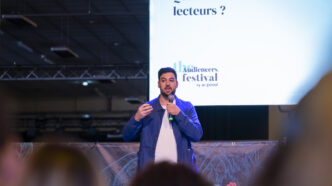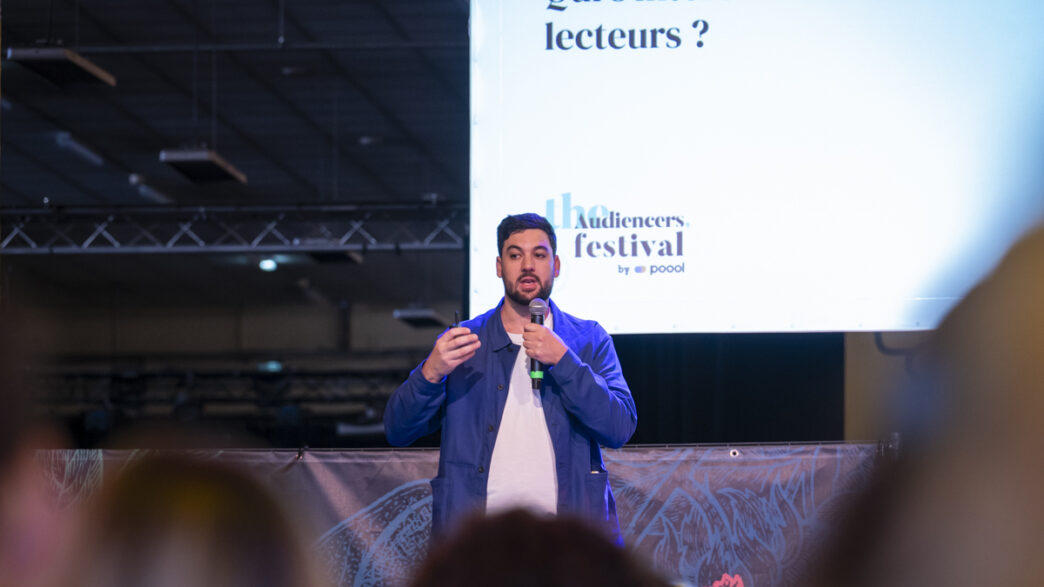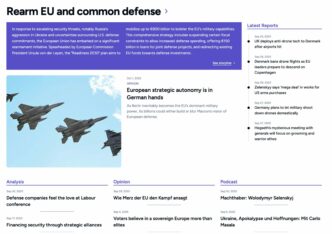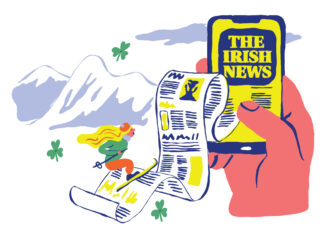

This article summarizes the session given by Max Leroy, Audience & Product Strategist, formerly of The New York Times, CNN, and POLITICO, at The Audiencers’ Festival in Paris on September 16th, 2025.
This session in 5 bullet points:
- The real danger to the media? Not AI or Google, but our disconnect from readers’ needs.
- Plummeting trust, dwindling audiences, refusal to pay: in any other industry, we would be talking about the collapse of product-market fit.
- Urgent action is needed: we must stop pointless obsessions and return to users’ needs.
- This series of articles presents five toxic obsessions and offers five useful obsessions for the sustainability of the media: short circuits, communities, respect for audience needs, experimentation, and advertising/UX balance.
- This first chapter covers obsession number one: exhausting ourselves by criticizing platforms.
What if the greatest threat to the media were neither AI, nor the “big bad wolf” Google, nor the decline in social traffic, not even the crisis in publishers’ business model? What if the real problem were us? Us and our persistent inability to take an interest in those we are supposed to serve: our readers.
The symptoms of this disconnect are measured each year by the Digital News Report and the figures for France are damning:
- Trust in free fall: Only 29% of French people still trust the media, compared to 39% 10 years ago. This score places us among the lowest in Europe, just ahead of Viktor Orbán’s Hungary
- An audience that shuns the news: More than a third of the population (36%) actively avoids the news, exhausted by information overload and paralyzed by information anxiety
- A value that is no longer perceived: Barely 11% of readers are willing to pay for online news
In any other industry, such a verdict would be final: the loss of product-market fit. The absolute priority would then be to stop everything and go back to talking to our users, understanding their pain points and needs, and reinventing our value proposition.
How did we get to the point where our product no longer meets an essential need of its audience?
Yet where do our eyes and conversations among media professionals turn? To the evolution of algorithms and the experiences of Google, Meta, X, and OpenAI, which are drying up our traffic sources. Or to the adoption of ad blockers and the end of third-party cookies, which are jeopardizing our advertising revenue… We are obsessed with other people’s products, those that impact our distribution. Meanwhile, a new generation of content creators is exploding, forging direct and authentic bonds of trust with their audience, something we no longer know how to do with ours.
Of course, the risks posed by platforms are real, and the political, legal, and economic battle to defend our value is necessary. But it must not become an excuse to paralyze what is essential: the work of our editorial, product, and marketing teams to urgently regain that product-market fit. We must focus our efforts on what we can control and accept the rest. Fear does not prevent danger.
Let’s dare to use a metaphor that’s not so far from reality. Imagine for a moment that traditional media are like historic car manufacturers, spending their days complaining about gas prices, CO2 emissions regulations, low-emission zones, or the end of combustion engines in 2035. Meanwhile, in a decade, electric cars have become more accessible and cycling in cities has made a strong comeback. Users have moved on: you don’t fight product-market fit, you pursue it.
It’s time to radically shift our obsessions. We need to abandon toxic topics over which we have limited influence and refocus on our main lever for action: our relationship with our current and potential audiences. In this series for The Audiencers, I invite you to explore five of these toxic obsessions that paralyze our teams. The hope is to replace them with five obsessions centered on the needs of our audiences and thus find our way back to product-market fit.
Toxic obsession 1/5 : Criticizing platforms
Our first toxic obsession is to waste time and energy denouncing platforms. We criticize their products, algorithms, and decisions, but let’s be clear: these companies are empires that write their own laws and have the means to listen to (almost) no one except Donald Trump, who supports them. Some executives even display a visceral, personal contempt for the press. Why, then, would they negotiate sincerely with us, when our dependence gives them all the leverage?
The fight for neighboring rights or against uncontrolled crawling is legitimate. But to wage it from a position of quasi-absolute digital vassalage is to condemn oneself to reaping only crumbs. The real leverage for negotiation lies neither in Brussels nor in the forums we sign, but in our direct relationship with our audience. To start a serious conversation with Google, it would be wise not to depend on its services (Search, News, Discover). For many media outlets in France, Google accounts for more than 50% of traffic, and in some cases more than 85%.
Faced with changes to their products—AI Overviews in particular—our instinct is to want to slow things down and demand guarantees. This ignores the reality of their market. Google is not on a crusade against the press; Google is fighting for its own survival in the face of the massive adoption of LLM chatbots as response engines by users. Google’s goal is to stay in the game by responding to this new need. In this battle of titans, we are neither their ally nor their enemy; we are simply the battlefield.
To replace this trait: Grow our audiences through short supply chains
Our obsession with platforms keeps us in a reactive, sterile, and exhausting position. Since the balance of power is stacked against us on their turf, the only viable strategic response is to change the playing field.
Rather than fighting to optimize increasingly precarious traffic, we must devote our resources to building short circuits with our audiences. It’s up to us to transform volatile, algorithm-dependent readers into a loyal and engaged audience that we can activate ourselves. This approach makes our newsletters, apps, events, and communities the main tools of our resilience strategy to resume negotiations from a better position.
[/restricted-content]












